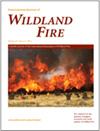Extending methods for assessing fuel hazard in temperate Australia to enhance data quality and consistency
IF 2.9
3区 农林科学
Q1 FORESTRY
引用次数: 0
Abstract
Background Assessments of fuel (vegetation) are needed to predict fire behaviour. Broad visual methods support quick in-field management decisions but can be too imprecise to detect variations in fuel for other purposes. Aims We evaluated the utility of integrating more comprehensive fuel measurement techniques into an existing visual fuel hazard assessment method. Methods We developed an extended method for measuring fuel hazard, including line-intercept measurements and clearer tables for assigning fuel hazard scores, and compared it with the existing Overall Fuel Hazard Assessment Guide fourth edition, which is often used in temperate Australia. Methods were tested across 69 eucalypt woodland plots of the same broad fuel type. Key results The existing method estimated higher near-surface and elevated cover compared with the extended method, but less surface cover. Assigned hazard scores changed markedly when using the clearer hazard tables. Over half the plots had differences of one or more in hazard score for surface, near-surface and elevated fuel between the existing and extended methods. Conclusions The extended method provided a more methodical and consistent approach for assessing fuel hazard, but was more time-consuming than the existing method. Implications The extended method provides an alternative method for monitoring and research purposes when data quality is important.扩展评估澳大利亚温带地区燃料危害的方法,以提高数据质量和一致性
预测火灾行为需要对燃料(植被)进行评估。广泛的可视化方法支持快速的现场管理决策,但可能过于不精确,无法检测到用于其他目的的燃料变化。我们评估了将更全面的燃料测量技术整合到现有的可视化燃料危害评估方法中的效用。我们开发了一种扩展的测量燃料危害的方法,包括线截距测量和用于分配燃料危害分数的更清晰的表,并将其与现有的第四版总体燃料危害评估指南进行了比较,该指南通常在澳大利亚温带地区使用。在69个相同燃料类型的桉树林地进行了方法测试。与推广方法相比,现有方法估算的近地表和高架覆盖度更高,但地表覆盖度更低。当使用更清晰的危害表时,分配的危害评分发生了显著变化。在现有方法和扩展方法之间,超过一半的地块在地表、近地表和高空燃料的危险评分上存在一个或多个差异。结论与现有方法相比,扩展后的方法更有条理和一致性,但耗时较长。当数据质量很重要时,扩展方法为监测和研究目的提供了另一种方法。
本文章由计算机程序翻译,如有差异,请以英文原文为准。
求助全文
约1分钟内获得全文
求助全文
来源期刊
CiteScore
5.50
自引率
9.70%
发文量
67
审稿时长
12-24 weeks
期刊介绍:
International Journal of Wildland Fire publishes new and significant articles that advance basic and applied research concerning wildland fire. Published papers aim to assist in the understanding of the basic principles of fire as a process, its ecological impact at the stand level and the landscape level, modelling fire and its effects, as well as presenting information on how to effectively and efficiently manage fire. The journal has an international perspective, since wildland fire plays a major social, economic and ecological role around the globe.
The International Journal of Wildland Fire is published on behalf of the International Association of Wildland Fire.

 求助内容:
求助内容: 应助结果提醒方式:
应助结果提醒方式:


